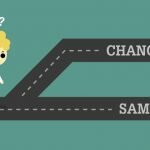“There is no such thing as a new idea. It is impossible. We simply take a lot of old ideas and put them into a sort of mental kaleidoscope. We give them a turn and they make new and curious combinations. We keep on turning and making new combinations indefinitely; but they are the same old pieces of colored glass that have been in use through all the ages.”
― Mark Twain
Every so often we hear this fear, or this realization: there are no new stories. It’s true, perhaps, but that doesn’t mean there’s no place for storytelling. The next time a client (or your team) is worrying about what new “original” content they can provide for their customers, point them this way.
How Can We be Creative with Old Stories?
My coworker at Mad*Pow Adam Connor has presented on the topic; he came to the conclusion that there are three types of creativity:
- Copying
- Extending
- Combining
According to Adam, these are the three ways we create. When we copy, we create a remake or re-envisioned story, such as the new Charlie and the Chocolate Factory. When we extend, we create sequels, such as the Fast and the Furious franchise. And when we combine, we take two ideas and make them into something new, such as Sharktopus.
Copying can take on other forms as well. Fast and the Furious and Point Break share an almost scene-by-scene breakdown, as do (intentionally Episodes 4 and 7 of Star Wars, A New Hope and The Force Awakens, respectively. The plot of Avatar is the same as the Disney version of Pocahontas. Yet all of these are done for different reasons. The Fast and the Furious and the original Point Break were appealing to a specific audience, and that pattern of scenes worked well. The creators of The Force Awakens (primarily J.J. Abrams) hoped to reignite a love for Star Wars with the original fans, and so purposely mirrored A New Hope. Avatar and Pocahontas meanwhile are intended for very different audiences, and yet coincidentally follow a well known story of an outsider becoming part of a strange or “foreign” group of people in the midst of a war.
Similarly, extending and combining can take many forms, ranging from sequel to parody to homage. And it’s not limited to film – the book Gone with the Wind has numerous sequels, none written by the original author, Margaret Mitchell. The song Bittersweet Symphony is based on The Rolling Stones’ song “The Last Time,” which in turn takes its tune from the Gospel song “This May Be The Last Time,” by The Staple Singers. And how many love stories are just variations on West Side Story, which is Romeo and Juliet, which is Pyramus and Thisbe?
What does this Mean for our Content Creativity?
So no, your team is not the first to struggle with finding new content to share. We live in an era of reused, retold, and recycled stories, and many are all the better for their numerous reconfigurations. But instead of looking for something original, focus on finding something valuable. Re-share older content, with a new perspective. Find another way of explaining something complicated, or simply re-share something from another source.
If it’s all been done before, then now is not the time to look for something completely original. Now is the time to find the best of what’s out there, and make it relevant to a new audience.


